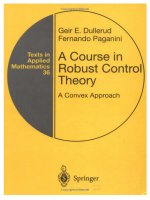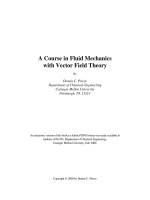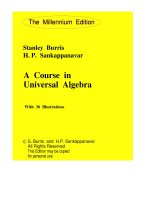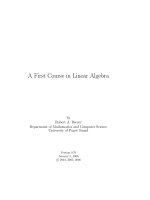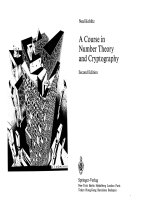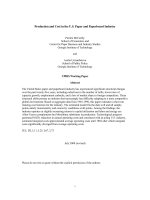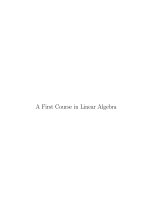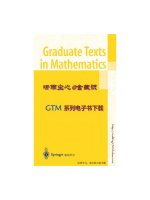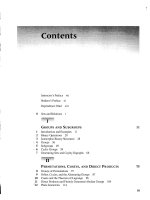a course in universal algebra - s. burris and h.p. sankappanavar
Bạn đang xem bản rút gọn của tài liệu. Xem và tải ngay bản đầy đủ của tài liệu tại đây (1.21 MB, 331 trang )
A Course in
Universal Algebra
H. P. Sankappanavar
Stanley Burris
With 36 Illustrations
c S. Burris and H.P. Sankappanavar
All Rights Reserved
This Edition may be copied
for personal use
The Millennium Edition
The Millennium Edition
This book is dedicated to our children
Kurosh Phillip Burris
Veena and Geeta and Sanjay Sankappanavar
Preface to the Millennium Edition
The original 1981 edition of A Course in Universal Algebra has now been
LaTeXed so the authors could make the out-of-print Springer-Verlag Gradu-
ate Texts in Mathematics edition available once again, with corrections. The
subject of Universal Algebra has flourished mightily since 1981, and we still
believe that A Course in Universal Algebra offers an excellent introduction
to the subject.
Special thanks go to Lis D’Alessio for the superb job of LaTeXing this
edition, and to NSERC for their support which has made this work possible.
v
Acknowledgments
First we would like to express gratitude to our colleagues who have added so much vital-
ity to the subject of Universal Algebra during the past twenty years. One of the original
reasons for writing this book was to make readily available the beautiful work on sheaves
and discriminator varieties which we had learned from, and later developed with H. Werner.
Recent work of, and with, R. McKenzie on structure and decidability theory has added to
our excitement, and conviction, concerning the directions emphasized in this book.
In the late stages of polishing the manuscript we received valuable suggestions from
M. Valeriote, W. Taylor, and the reviewer for Springer-Verlag. For help in proof-reading we
also thank A. Adamson, M. Albert, D. Higgs, H. Kommel, G. Krishnan, and H. Riedel. A
great deal of credit for the existence of the final product goes to Sandy Tamowski whose
enthusiastic typing has been a constant inspiration. The Natural Sciences and Engineering
Research Council of Canada has generously funded both the research which has provided
much of the impetus for writing this book as well as the preparation of the manuscript
through NSERC Grant No. A7256. Also thanks go to the Pure Mathematics Department of
the University of Waterloo for their kind hospitality during the several visits of the second
author, and to the Institute of Mathematics, Federal University of Bahia, for their generous
cooperation in this venture.
The second author would most of all like to express his affectionate gratitude and ap-
preciation to his wife—Nalinaxi—who, over the past four years has patiently endured the
many trips between South and North America which were necessary for this project. For
her understanding and encouragement he will always be indebted.
vii
Preface
Universal algebra has enjoyed a particularly explosive growth in the last twenty years, and
a student entering the subject now will find a bewildering amount of material to digest.
This text is not intended to be encyclopedic; rather, a few themes central to universal
algebra have been developed sufficiently to bring the reader to the brink of current research.
The choice of topics most certainly reflects the authors’ interests.
Chapter I contains a brief but substantial introduction to lattices, and to the close con-
nection between complete lattices and closure operators. In particular, everything necessary
for the subsequent study of congruence lattices is included.
Chapter II develops the most general and fundamental notions of universal algebra—
these include the results that apply to all types of algebras, such as the homomorphism and
isomorphism theorems. Free algebras are discussed in great detail—we use them to derive
the existence of simple algebras, the rules of equational logic, and the important Mal’cev
conditions. We introduce the notion of classifying a variety by properties of (the lattices of)
congruences on members of the variety. Also, the center of an algebra is defined and used to
characterize modules (up to polynomial equivalence).
In Chapter III we show how neatly two famous results—the refutation of Euler’s con-
jecture on orthogonal Latin squares and Kleene’s characterization of languages accepted by
finite automata—can be presented using universal algebra. We predict that such “applied
universal algebra” will become much more prominent.
Chapter IV starts with a careful development of Boolean algebras, including Stone du-
ality, which is subsequently used in our study of Boolean sheaf representations; however,
the cumbersome formulation of general sheaf theory has been replaced by the considerably
simpler definition of a Boolean product. First we look at Boolean powers, a beautiful tool
for transferring results about Boolean algebras to other varieties as well as for providing a
structure theory for certain varieties. The highlight of the chapter is the study of discrimi-
nator varieties. These varieties have played a remarkable role in the study of spectra, model
companions, decidability, and Boolean product representations. Probably no other class of
varieties is so well-behaved yet so fascinating.
The final chapter gives the reader a leisurely introduction to some basic concepts, tools,
and results of model theory. In particular, we use the ultraproduct construction to derive the
compactness theorem and to prove fundamental preservation theorems. Principal congruence
ix
x Preface
formulas are a favorite model-theoretic tool of universal algebraists, and we use them in the
study of the sizes of subdirectly irreducible algebras. Next we prove three general results on
the existence of a finite basis for an equational theory. The last topic is semantic embeddings,
a popular technique for proving undecidability results. This technique is essentially algebraic
in nature, requiring no familiarity whatsoever with the theory of algorithms. (The study
of decidability has given surprisingly deep insight into the limitations of Boolean product
representations.)
At the end of several sections the reader will find selected references to source material
plus state of the art texts or papers relevant to that section, and at the end of the book one
finds a brief survey of recent developments and several outstanding problems.
The material in this book divides naturally into two parts. One part can be described
as “what every mathematician (or at least every algebraist) should know about universal
algebra.” It would form a short introductory course to universal algebra, and would consist
of Chapter I; Chapter II except for §4, §12, §13, and the last parts of §11, §14; Chapter
IV §1–4; and Chapter V §1 and the part of §2 leading to the compactness theorem. The
remaining material is more specialized and more intimately connected with current research
in universal algebra.
Chapters are numbered in Roman numerals I through V, the sections in a chapter are
given by Arabic numerals, §1, §2, etc. Thus II§6.18 refers to item 18, which happens to
be a theorem, in Section 6 of Chapter II. A citation within Chapter II would simply refer
to this item as 6.18. For the exercises we use numbering such as II§5 Exercise 4, meaning
the fourth exercise in §5 of Chapter II. The bibliography is divided into two parts, the first
containing books and survey articles, and the second research papers. The books and survey
articles are referred to by number, e.g., G. Birkhoff [3], and the research papers by year, e.g.,
R. McKenzie [1978].
xi
Diagram of Prerequisites
III IV
V
II
I
Chapter I
2
1
1
4
5
1
6
7
Chapter II
5
6
7
8
9
11
12
1314
1
Chapter III
1
22
22
43
5
4
3
4
3
10
11
9
8
5
3
3
4
12
13
Chapter IV Chapter V
10
Contents
Special Notation xv
Preliminaries 1
I Lattices 5
§1. DefinitionsofLattices 5
§2. Isomorphic Lattices, and Sublattices . 10
§3. DistributiveandModularLattices 12
§4. CompleteLattices,EquivalenceRelations,andAlgebraicLattices 17
§5. ClosureOperators 20
II The Elements of Universal Algebra 25
§1. DefinitionandExamplesofAlgebras 25
§2. Isomorphic Algebras, and Subalgebras 31
§3. Algebraic Lattices and Subuniverses . . 33
§4. The Irredundant Basis Theorem 35
§5. CongruencesandQuotientAlgebras 38
§6. HomomorphismsandtheHomomorphismandIsomorphismTheorems 47
§7. Direct Products, Factor Congruences, and Directly Indecomposable Algebras 55
§8. Subdirect Products, Subdirectly Irreducible Algebras, and Simple Algebras . 62
§9. ClassOperatorsandVarieties 66
§10.Terms,TermAlgebras,andFreeAlgebras 68
§11.Identities,FreeAlgebras,andBirkhoff’sTheorem 77
§12.Mal’cevConditions 85
§13.TheCenterofanAlgebra 91
§14.EquationalLogicandFullyInvariantCongruences 99
III Selected Topics 111
§1. SteinerTripleSystems,Squags,andSloops 111
§2. Quasigroups,Loops,andLatinSquares 114
§3. Orthogonal Latin Squares 115
xiii
xiv Contents
§4. Finite State Acceptors 119
IV Starting from Boolean Algebras 129
§1. BooleanAlgebras 129
§2. BooleanRings 136
§3. FiltersandIdeals 142
§4. StoneDuality 152
§5. BooleanPowers 159
§6. UltraproductsandCongruence-distributiveVarieties 163
§7. PrimalAlgebras 169
§8. BooleanProducts 174
§9. DiscriminatorVarieties 186
§10.QuasiprimalAlgebras 191
§11.FunctionallyCompleteAlgebrasandSkew-freeAlgebras 199
§12.SemisimpleVarieties 207
§13.DirectlyRepresentableVarieties 212
V Connections with Model Theory 217
§1. First-orderLanguages,First-orderStructures,andSatisfaction 217
§2. ReducedProductsandUltraproducts 234
§3. PrincipalCongruenceFormulas 252
§4. ThreeFiniteBasisTheorems 259
§5. Semantic Embeddings and Undecidability 271
Recent Developments and Open Problems 283
§1. TheCommutatorandtheCenter 283
§2. TheClassificationofVarieties 284
§3. Decidability Questions 285
§4. BooleanConstructions 287
§5. StructureTheory 288
§6. ApplicationstoComputerScience 289
§7. ApplicationstoModelTheory 289
§8. FiniteBasisTheorems 290
§9. SubdirectlyIrreducibleAlgebras 290
Bibliography 291
§1. BooksandSurveyArticles 291
§2. ResearchPapersandMonographs 293
Author Index 303
Subject Index 306
Special Notation
(A
i
)
i∈I
1
A − B 1
rˇ1
|A|2
≈3
∨,∧5
≤6, 31
l.u.b., sup 6
g.l.b., inf 7
≺ 7
Q
P
(as a poset) 11
L(P )12
I(L)12
M
5
,N
5
13
J(L)16
,
17
r
1
◦ r
2
18
∆, ∇ 18
Eq(A)18
a/θ, A/θ 18
Π(A)19
θ(π)19
L
C
21
F 26, 217
A = A, F 26
f
A
26
Sg(X)33
E(X)33
Sub(A)33
Sub(A)33
C
n
(X)35
IrB 36
A/θ 39
Con A 39
Con A 40
Θ40
Θ(a
1
,a
2
)41
Θ(X)41
CEP 46
α(A)47
α
−1
(A)48
ker(α)49
φ/θ 51
B
θ
52
θ
B
52
[
[
[a, b]
]
]54
A
1
×A
2
56
π
i
56, 58
i∈I
A
i
58
A
I
59
θ
a,b
64
I,S,H,P,P
S
66
V 67
T (X)68
p
A
69
T(X)71
θ
K
(X)73
Φ
K
(X)73
F
K
(X)73
p=p(x
1
, ,x
n
)73
p≈q 77
|= 78, 221
Id
K
(X)78
|=78
M(Σ) 82
Z(A)91
xv
xvi SPECIAL NOTATION
A
A
93
Con
FI
(A)99
Θ
FI
(S) 100
D(Σ) 104
105
L(A) 120
≡
L
126
Su(X) 131
1, 2 131
B a 132
B
⊗
137
R
⊗
138
I(X),F(X) 147
B
∗
152
X
1
∪ X
2
,X
1
·∪X
2
156
A[B]
∗
159
A[B]
∗
159
[[ ]] 161, 235
θ
U
163
i∈I
A
i
/U 164, 239
P
U
(K) 165, 239
Spec A 183
Spec (V ) 191
2
L
199
θ
1
×···×θ
n
200
L, R 217
A = A, L 218
f
A
,r
A
218
L(X) 218
&, ∨, ¬, →, ↔, ∀, ∃ 218
L
A
220
A ≺ B,S
(≺)
227
Spec φ 233
θ
F
234
a/F 235
i∈I
A
i
/F 235
P
R
(K) 235
Th(K) 243
Th
∀
245
Th
∀H
249
A 251
D
+
252
V
FSI
266
sem
272
K(c
1
, ,c
n
) 272
sem
−−→ 279
Preliminaries
We have attempted to keep our notation and conventions in agreement with those of the
closely related subject of model theory, especially as presented in Chang and Keisler’s Model
Theory [8]. The reader needs only a modest exposure to classical algebra; for example he
should know what groups and rings are.
We will assume a familiarity with the most basic notions of set theory. Actually, we use
classes as well as sets. A class of sets is frequently called a family of sets. The notations,
A
i
,i∈I, and (A
i
)
i∈I
refer to a family of sets indexed by a set I. A naive theory of sets
and classes is sufficient for our purposes. We assume the reader is familiar with membership
(∈), set-builder notation ({—:—}), subset (⊆), union (∪), intersection (∩), difference (−),
ordered n-tuples (x
1
, ,x
n
),(direct) products of sets (A×B,
i∈I
A
i
), and (direct) powers
of sets (A
I
). Also, it is most useful to know that
(a) concerning relations:
(i) an n-ary relation on a set A is a subset of A
n
;
(ii) if n = 2 it is called a binary relation on A;
(iii) the inverse rˇ of a binary relation r on A is specified by a, b∈rˇiffb, a∈r;
(iv) the relational product r◦s of two binary relations r, s on A is given by: a, b∈r◦s
iff for some c, a, c∈r, c, b∈s;
(b) concerning functions:
(i) a function f from a set A toasetB, written f : A → B, is a subset of A × B
such that for each a ∈ A there is exactly one b ∈ B with a, b∈f; in this case
we write f (a)=bor f : a → b;
(ii) the set of all functions from A to B is denoted by B
A
;
(iii) the function f ∈ B
A
is injective (or one-to-one)iff(a
1
)=f(a
2
)⇒a
1
=a
2
;
(iv) the function f ∈ B
A
is surjective (or onto) if for every b ∈ B there is an a ∈ A
with f(a)=b;
1
2 Preliminaries
(v) the function f ∈ B
A
is bijective if it is both injective and surjective;
(vi) for f ∈ B
A
and X ⊆ A, f(X)={b∈B:f(a)=bfor some a ∈ X};
(vii) for f ∈ B
A
and Y ⊆ B, f
−1
(Y )={a∈A:f(a)∈Y};
(viii) for f : A → B and g : B → C, let g ◦ f : A → C be the function defined by
(g ◦ f)(a)=g(f(a)). [This does not agree with the relational product defined
above—but the ambiguity causes no problem in practice.];
(c) given a family F of sets, the union of F,
F, is defined by a ∈
F iff a ∈ A for some
A ∈ F (define the intersection of F,
F, dually);
(d) a chain of sets C is a family of sets such that for each A, B ∈ C either A ⊆ B or
B ⊆ A;
(e) Zorn’s lemma says that if F is a nonempty family of sets such that for each chain C of
members of F there is a member of F containing
C (i.e., C has an upper bound in
F )thenF has a maximal member M (i.e., M ∈ F and M ⊆ A ∈ F implies M = A);
(f) concerning ordinals:
(i) the ordinals are generated from the empty set ∅ using the operations of successor
(x
+
= x ∪{x})andunion;
(ii) 0 = ∅, 1=0
+
, 2=1
+
,etc.; the finite ordinals are 0, 1, ;andn={0,1, ,n−
1};thenatural numbers are 1, 2, 3 , the nonzero finite ordinals;
(iii) the first infinite ordinal is ω = {0, 1, 2, };
(iv) the ordinals are well-ordered by the relation ∈, also called <;
(g) concerning cardinality:
(i) two sets A and B have the same cardinality if there is a bijection from A to B;
(ii) the cardinals are those ordinals κ such that no earlier ordinal has the same car-
dinality as κ. The finite cardinals are 0, 1, 2, ;andωis the smallest infinite
cardinal;
(iii) the cardinality of a set A, written |A|, is that (unique) cardinal κ such that A and
κ have the same cardinality;
(iv) |A|·|B|=|A×B|[= max(|A|, |B|) if either is infinite and A, B = ∅] .A∩B=
∅⇒|A|+|B|=|A∪B| [= max(|A|, |B|) if either is infinite];
(h) one usually recognizes that a class is not a set by noting that it is too big to be put in
one-to-one-correspondence with a cardinal (for example, the class of all groups).
3
In Chapter IV the reader needs to know the basic definitions from point set topology,
namely what a topological space,aclosed (open) set,asubbasis (basis) for a topological space,
a closed (open) neighborhood of a point, a Hausdorff space, a continuous function, etc., are.
The symbol “=” is used to express the fact that both sides name the same object, whereas
“≈” is used to build equations which may or may not be true of particular elements. (A
careful study of ≈ is given in Chapter II.)
